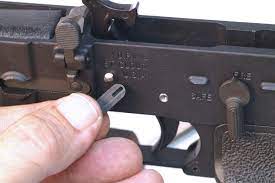Understanding Your AR-15’s Trigger

The ideal trigger should break abruptly, preventing you from flinching in anticipation of the shot’s recoil. This will allow you to significantly improve your accuracy. When you are confident that the trigger will behave as expected, you can focus on the shot rather than the trigger’s dependability.
Another advantage of having a good trigger is the ability to fire a shot without having to pull the trigger all the way back. Because of the short travel distance, you can shoot with greater precision, and you can quickly reset the following shot.
Dual-Stage vs. Single-Stage
The first stage of a dual-stage trigger provides more substantial resistance to the trigger pull, followed by stage 2, which provides minor resistance, and finally, the trigger break. Dual-stage triggers have two distinct stages of trigger pull.
Many people believe that a single-stage trigger is superior for use at close range or during rapid shooting because it resets at a faster rate. A two-stage trigger, on the other hand, improves long-range accuracy. In the end, the choice of which stage to play on comes down to personal preference. Keeping this in mind, you can select the trigger for your AR-15, as well as the other AR-15 parts, based on the function it will serve.
The Amount Of Force Required To Pull The Trigger
The application’s functionality will determine the best draw weight for the trigger. When shooting at close range, a “general purpose” trigger with a slightly heavier draw weight is preferred over a “match grade” trigger with a very light trigger pull. This is because a lighter trigger increases the likelihood of the weapon being pulled by accident.
The trigger pulls metric measures the amount of force required to pull the trigger in pounds. As the number increases, pressing the button becomes more difficult. Using a trigger with a smaller pull weight improves accuracy because it requires less effort to press the trigger. As a result, you should be cautious of any unexpected discharges. Light triggers are also referred to as “match triggers” because they are so commonly used in long-range shooting competitions.
A trigger pull weighs between three and six pounds on average. A rifle with multiple uses should not weigh more than 4 pounds. A match-grade trigger, on the other hand, could be of lower quality.
Curved vs. Flat Triggers
Some triggers have flat surfaces, but the vast majority have curved surfaces where your finger rests. Some people prefer curved triggers, while others prefer flat triggers. This is entirely up to the individual. Experiment with each one to see which one feels more natural to you. Everything is dependent on how comfortable you are with pulling the trigger when making decisions.
The Installation and Setup Procedure
Although switching triggers has a number of advantages, not all triggers are created equal, and the kits in which they are sold can be simple or complex. When shopping for a trigger upgrade, look for a “drop-in” kit because it may be easier to install. Working with small trigger springs can be difficult when working with a kit that contains loose parts.
Small Pin vs. Large Pin
The type of receiver determines the type of trigger used. Despite the fact that “small pin” is the military standard for AR-15 receivers, some vintage Colt AR receivers have a “large pin.” If you’re not sure what you’ve got, measure the pinhole in the front of the takedown. In that case, you have a pin receiver that is smaller in size. A length of thirty inches The massive pin measures 315 millimeters in length.
Gun Safety
The term “gun safety” refers to a set of procedures that ensure firearms are handled, stored, and used safely at all times. Gun accidents and injuries can be reduced if proper gun safety procedures are followed consistently. Maintain a safe muzzle angle, keep your finger off the trigger until ready to fire, keep the gun empty until ready to use, and be constantly aware of both your target and what lies beyond it. These are the four most important rules for safe gun handling. Understand your goal as well as the context in which it exists.
When handling a firearm, you should always ensure that the muzzle is pointing in a safe direction. This includes always aiming the handgun away from yourself and others and never aiming it at an object at which you do not intend to fire it. Safe gun handling requires keeping the firearm pointed away from yourself and others. Furthermore, you should never point a handgun at a moving target. Keep your finger off the trigger until you are certain you are ready to fire the weapon. Keep your finger away from the trigger. As a result, there is no longer any possibility of accidental discharges. You should keep the weapon in its empty state until you are ready to use it. Unauthorized use and accidents become less likely as a result.
When not in use, a firearm should be stored in a location that is both safe and secure, as well as inaccessible to anyone other than the owner. It is critical that you understand both the goal you have set for yourself and the environment that surrounds it. This ensures that you only aim at the chosen target and that you are always aware of what is beyond the target.
Safe gun handling should be a top priority for anyone who owns or uses a weapon. If you follow the four essential gun safety principles, you can help to reduce the number of accidents and injuries caused by firearms. These prerequisites are as follows:
How Can You Tell If a Gun Is Loaded With Bullets?
Examining the firearm’s chamber is the most accurate way to determine whether or not it is loaded with ammunition. To do so, you must first ensure that the weapon is pointed in a safe direction. After the magazine is removed, the action may finally begin in the event that a magazine is available. If you see a bullet in the chamber of a handgun, you can be sure it’s loaded, and you should take precautions right away to protect yourself. If there is no ammo in the gun’s chamber, it is considered empty, and you should proceed with extreme caution. Always treat a firearm as if it were loaded whenever you handle it.
Instructions for Emptying a Fully Loaded Gun
There is no such thing as being overly cautious in armed conflict. It doesn’t matter if you own a gun or just spend a lot of time around weapons; knowing how to disarm a pistol is essential. This ability has the potential to save your life in the event of a traumatic event such as an accident or a violent crime.
To safely disarm a pistol, there are primarily two approaches that can be taken. The first step is to remove the magazine from the firearm. As a result, the firearm will be inoperable until the magazine is replaced. The second thing you must do is empty the pistol’s chamber. Furthermore, the firearm will be declared unusable and cannot be used until it can be reloaded.
If you are unsure how to securely disarm a firearm, consult an expert who will be able to guide you through the process. There is a wide range of gun safety courses available to you, each of which will teach you how to handle firearms properly.
Additional Firearms Safety Considerations
There are a few other things to keep in mind when handling a handgun, in addition to the three fundamental principles of gun safety that everyone should be familiar with. These things should not be taken lightly. When handling a firearm, especially a handgun, always exercise extreme caution. Never play with or treat a firearm as if it were a toy, as this is extremely dangerous.
Please click here to learn more.










